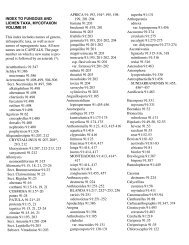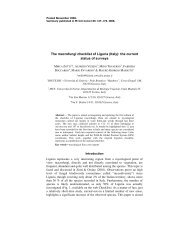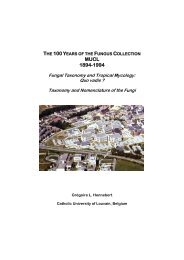download full review [pdf] - Mycotaxon
download full review [pdf] - Mycotaxon
download full review [pdf] - Mycotaxon
Create successful ePaper yourself
Turn your PDF publications into a flip-book with our unique Google optimized e-Paper software.
<strong>Mycotaxon</strong> 110 Book Reviews ... 517<br />
Following an outline classification showing the various genera assigned to<br />
family is a description of the genera. These are arranged alphabetically, and<br />
each has a <strong>full</strong> page with information on the etymology, characters, number of<br />
species, distribution, seasonality, references to keys and descriptions, comments,<br />
and a coloured photograph showing both intact and sliced sporocarps. No<br />
illustrations or photomicrographs are included, which was disappointing to<br />
me as so many of these fungi have such wonderful spores. There is a series of<br />
four keys to the genera, but as this work is not intended as a comprehensive<br />
identification guide, there are no keys to species. However, the CD inside the<br />
back cover has fine macrophotographs of 111 species, as well as a movie “A<br />
truffle hunt with Jim Trappe,” showing him in action with his special truffle<br />
rake.<br />
This book could be seen as a series of courses in a menu, and the next<br />
continues to delight. Entitled “Ecology of truffles”, it has the best coloured<br />
shots of mycorrhizal roots sheathed by truffle fungi that I have seen in print,<br />
some from synthesis cultures and others from nature. The authors stress that,<br />
compared to ectomycorrhizal mushrooms, these fungi typically display narrow<br />
host ranges – often to a single host genus, such as Alpova diplophloeus, which is<br />
evidently restricted to Alnus. The importance of truffles in ecosystem processes<br />
is discussed in relation to nutrient cycling and soil structure, mycorrhizal<br />
networks, soil food webs, and small mammal mycophagy. The mycophagy can<br />
be obligate, preferential, or casual, but is documented here for no less than 45<br />
mammals and birds in the Pacific Northwest, including bears, chipmunks, goats,<br />
gophers, jays, marmots, voles, and even the high-profile Northern spotted owl.<br />
If you need examples to help sell the importance of fungi in the conservation<br />
arena, there is no shortage of striking examples here. Following discussion<br />
of the effects of different silvicultural practices, implications for wildlife, and<br />
inoculation procedures, the next course is on gastronomy with tempting dishes<br />
displayed, and naturally leads to cultivation in plantations and the conservation<br />
of natural resources. The dessert is a 3⅓ page summary of 12 principles of<br />
management practices and considerations that merit promulgation throughout<br />
the conservation and forestry audiences, and I trust this will be given a wider<br />
circulation than in this one report.<br />
This is splendid work that all fungal conservationists could read with benefit<br />
to “provide the underpinning for conserving this fascinating and important<br />
group of forest organisms” (p. 164). There is no price indicated, but somewhat<br />
dauntingly the back cover bears the warning: “Penalty for private use, $300.” I do<br />
hope that should be interpreted as meaning that if you do receive or otherwise<br />
obtain a copy, you risk a fine for not sharing the information it contains!


![download full review [pdf] - Mycotaxon](https://img.yumpu.com/5381692/9/500x640/download-full-review-pdf-mycotaxon.jpg)




